The Desktop Kabini Review Part 1: AMD Athlon 5350 (AM1) Tested
by Ian Cutress on April 9, 2014 8:00 AM ESTIGP Comparison, Synthetics
AMD’s graphics stack from top to bottom is all based on the Graphics Core Next architecture. This is an update from earlier VLIW implementations, offering for scalability from low power all the way up to high performance. At the heart of an AMD graphics system is the compute unit comprising of 64 GPU cores. Each compute unit can act independently, ensuring that multiple tasks can complete as quickly as possible due to multiple kernel dispatch across the entire core. In the Kaveri APU launch we were dealing with APUs that contained 6 or 8 compute units for 384/512 cores. With this level of performance, gaming at 1080p30 was possible on most titles depending on how the quality settings were configured. For Kabini, the entire range is given two compute units, with individual processors differing in clock speed.
With two compute units, we are not expecting much from the gaming aspect of these APUs in terms of ‘the latest’ titles. Our benchmarks in the next few pages show that even F1 2013 at 1280x1024 on low settings, unless the engine powering the game is basic, 25 FPS minimum is a hopeful target. This lack of horsepower may limit these APUs to Flash based titles, perhaps even some of the more reasonable Unity games. In AMD’s slide deck they quote games such as Minecraft, Lego Marvel Superheroes and Bastion as the sort of titles that a Kabini player should aim for.
There is some confusion regarding the naming convention of these integrated graphics solutions. Soldered on Kaveri parts designed for all-in-ones, such as the A6-5200, use the HD8000 naming scheme, such as the HD8400. The Athlon 5350 is analogous in design to the A6-5200 except for a 50 MHz speed bump and the name of the IGP – here this is designated as the R3 series. This is despite retailers who are currently selling this APUs and labeling them with the HD8000 designations.
Like Kaveri, the integrated graphics solution in Kabini features an updated Video Codec Engine and Unified Video Decoder giving hardware support for H.264.
AMD is also promoting their Picture Perfect solution, using additional post processing tools to increase video quality on the fly:
Also rather interestingly AMD is claiming an enhanced decoder for JPEG files. Given that one of the primary uses for a Kabini system might be for web access where JPEGs are standard, AMD has been promoting up to a 2x performance increase over a J2900 system:
AMD’s secret sauce, according to their slides, appears to be heterogeneous computing. This would be the ideal usage scenario for computing going forward.
GPU Synthetics
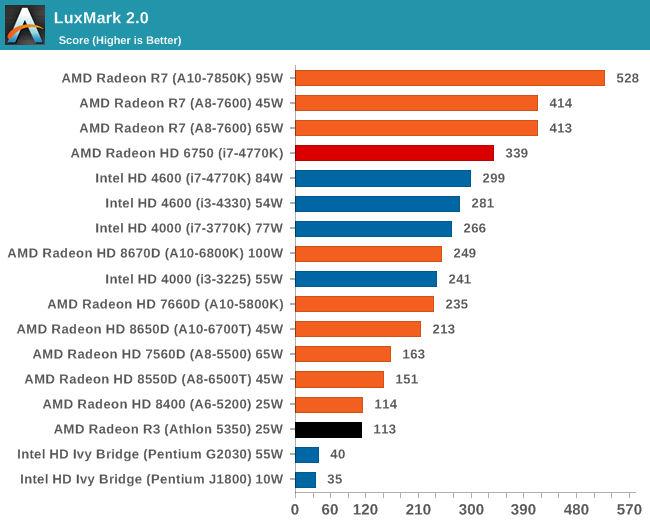
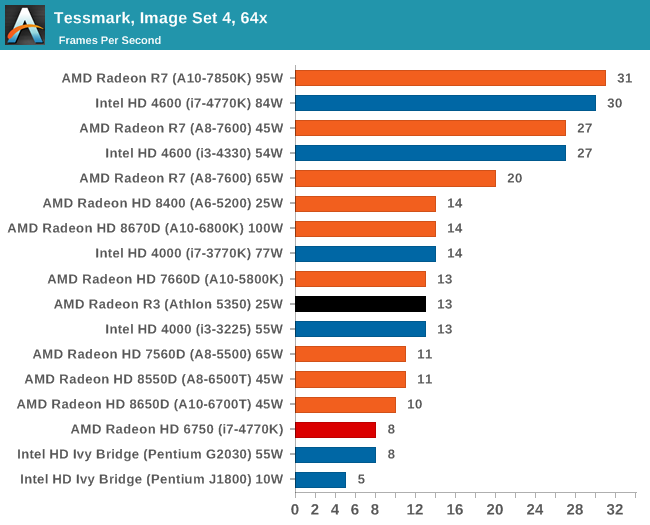


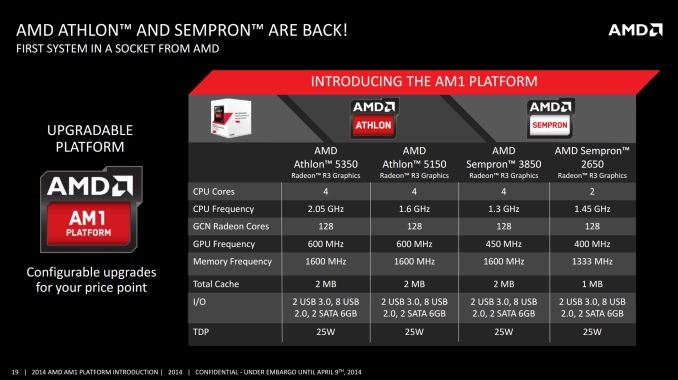
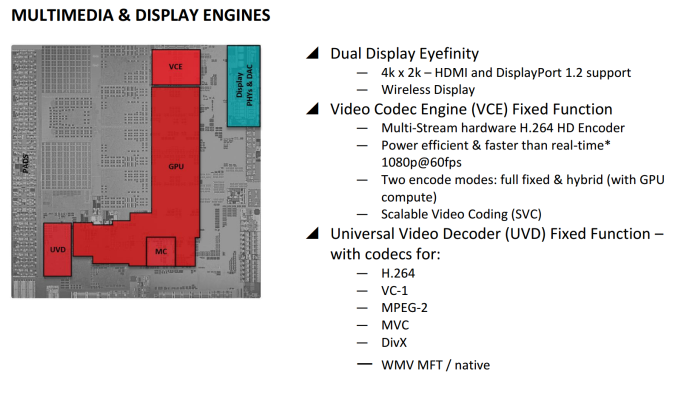
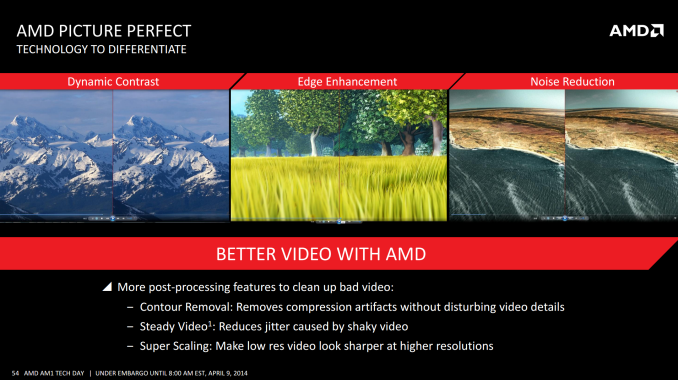
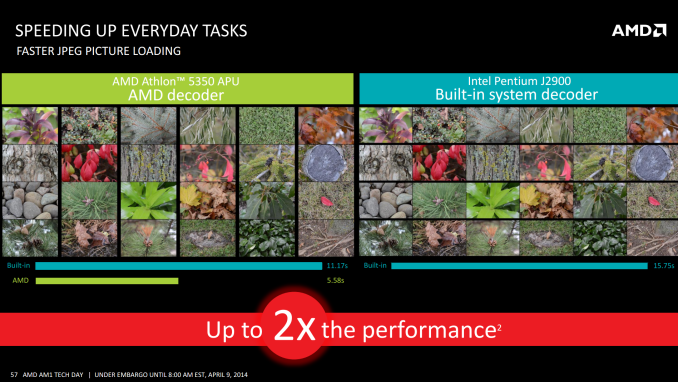
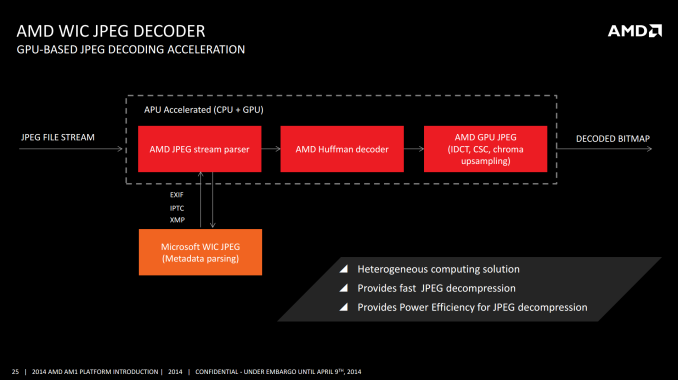








126 Comments
View All Comments
kyuu - Wednesday, April 9, 2014 - link
Yeah I was going to say something about that. The article text and the graphs are not in agreement.kallogan - Wednesday, April 9, 2014 - link
ground breaking new tech ! Wow !Alexey291 - Thursday, April 10, 2014 - link
wowsuch tech
much ground breaking
wow
evonitzer - Wednesday, April 9, 2014 - link
In addition to what you are already planning to test, I would like to see some of the low end A4 or A6 APU's tested. They seem to be a blank spot for your reviews, making it tough to compare the cheap stuff against the previous generation. The A4's come with the same 2 CU GPU, but presumably better cpu performance, and are available pretty close to $50. Sure, they are higher TDP, but whatev.Anyway, interesting review. I'd be seriously tempted if I didn't just put together a cheap PC for my brother already. Maybe grandma can get a surprise upgrade ...
evonitzer - Wednesday, April 9, 2014 - link
Oh hold on, there aren't any A4's or A6's available in Kaveri form, which means no GCN to be had for cheap. That's interesting. I wonder how much difference it makes on the low end. Well either way, the A4-6300 (and below) are still interesting to compare.Glory2God - Wednesday, April 9, 2014 - link
That Atom C2750 looks awesome in the multi threaded benchmarks.rogueninja - Wednesday, April 9, 2014 - link
AMD dualcore, quadcore, octacore, 100 cores. Who give a damn. They're as fast as a turtle.Nintendo Maniac 64 - Wednesday, April 9, 2014 - link
Would have been nice if there were more older CPUs to compare to, like Athlon 64 x2, first gen Phenom X4, and Conroe Core 2 Duo (rather than Wolfdale). It'd be even better if said older CPUs were around 2.0-2.5GHz as wellsaiki4116 - Wednesday, April 9, 2014 - link
Please add comparison with A4-4000(40 USD) and A4-6300,they could cost 10-20usd more than kabini.BushLin - Wednesday, April 9, 2014 - link
Anandtech, where's the power consumption figures? Just quoting the 25w TDP feeds assumptions such as the one I'm replying to.Why is it every time AMD have a CPU worth buying (doesn't happen that often) you guys manage to totally miss the point in the review? It's enough to make an objective person sound like a fanboy.
I'll save you the trouble:
http://www.tomshardware.com/reviews/athlon-5350-am...
Although making the typical reviewer mistake of using a very high wattage PSU on a low power system, we can at least see something close to parity between an Athlon 5350 and a Celeron J1900 (the very same CPUs you reviewed).
Makes quite a different outcome doesn't it?